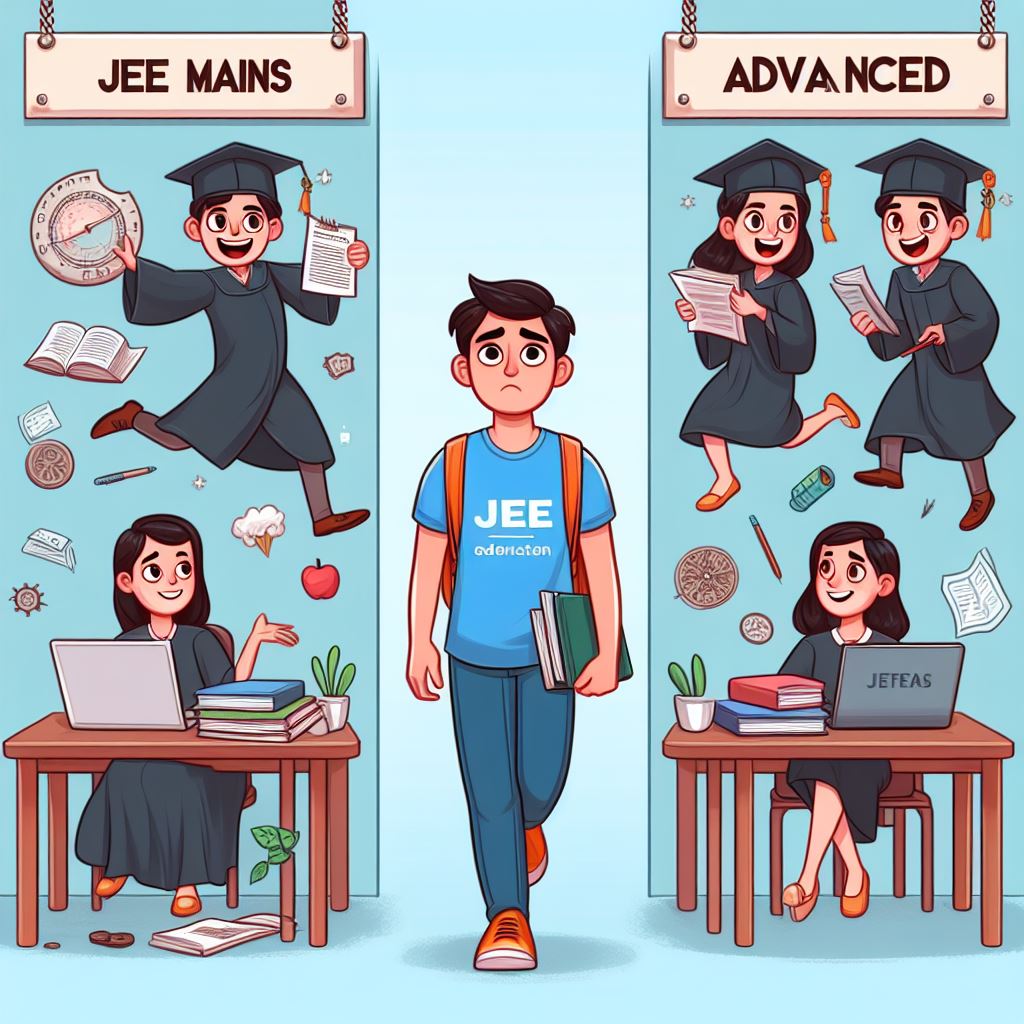Introduction
Embarking on the journey towards engineering college admission in India means navigating through a series of challenging exams, with the Joint Entrance Examination (JEE) being the ultimate gateway.
Within the realm of JEE, there are two main components: JEE Main and JEE Advanced. In this blog post, we’ll explore the key differences between these two exams, helping you understand their unique characteristics and implications for your academic journey.
Understanding JEE Main:
JEE Main serves as the preliminary screening test for admission to undergraduate engineering programs across various colleges in India, including the prestigious National Institutes of Technology (NITs), Indian Institutes of Information Technology (IIITs), and other centrally funded technical institutions. Here are some key aspects of JEE Main:
- Exam Pattern: The exam consists of multiple-choice questions (MCQs) in Physics, Chemistry, and Mathematics, with equal weightage given to each subject. It also includes numerical value-based questions.
- Eligibility Criteria: Candidates must have completed their 10+2 examination or equivalent with Physics, Chemistry, and Mathematics as compulsory subjects. Additionally, there are certain age and attempt limit criteria that candidates must meet.

Understanding JEE Advanced:
JEE Advanced is the next level of the examination hierarchy and is designed for candidates who qualify the JEE Main and aspire to secure admission to the prestigious Indian Institutes of Technology (IITs). Here are the distinguishing features of JEE Advanced:
- Exam Frequency: JEE Advanced is conducted once a year, usually in May or June, following the JEE Main examination. It is exclusively held for candidates who qualify the JEE Main and meet the specified cutoff criteria.
- Exam Pattern: Unlike JEE Main, JEE Advanced follows a more comprehensive and analytical approach, with questions designed to assess candidates’ understanding of concepts and problem-solving skills. The exam consists of two papers, each covering Physics, Chemistry, and Mathematics.
- Eligibility Criteria: In addition to qualifying the JEE Main, candidates must meet certain eligibility criteria set by the respective IITs, including age restrictions and minimum percentage requirements in the qualifying examination.
Understanding the Key Differences:
Now that we’ve outlined the basic characteristics of JEE Main and JEE Advanced, let’s delve deeper into the key differences between the two exams:
- Scope and Difficulty Level:
JEE Main primarily tests candidates on their knowledge and understanding of fundamental concepts in Physics, Chemistry, and Mathematics. The questions are of moderate difficulty level, focusing on conceptual clarity and application.
On the other hand, JEE Advanced is renowned for its challenging nature, with questions that require a deeper understanding of concepts and a high level of analytical and problem-solving skills. The exam aims to identify the brightest minds capable of excelling in rigorous academic programs offered by the IITs.
- Seat Allocation and Institutes:
Performance in JEE Main determines admission to a wide range of engineering colleges and institutes across India, including NITs, IIITs, and other centrally funded technical institutions. The All India Ranks (AIRs) obtained in JEE Main are used for seat allocation in these institutes.
In contrast, JEE Advanced serves as the gateway to the prestigious IITs, which are renowned for their world-class education and research facilities. Admission to IITs is based solely on the AIRs obtained in JEE Advanced, with candidates vying for a limited number of seats in various undergraduate engineering programs.
- Exam Preparation and Strategy:
Given the differences in exam pattern and difficulty level, candidates need to adopt distinct preparation strategies for JEE Main and JEE Advanced. While JEE Main preparation focuses on building a strong foundation in core concepts and practicing a wide range of problems, JEE Advanced preparation demands a more in-depth understanding of concepts and regular practice of complex problem-solving techniques.
Candidates aspiring for success in both exams should start their preparation early, stay consistent in their studies, and utilize resources such as NCERT textbooks, reference books, online study materials, and mock tests to assess their progress and identify areas for improvement.
Conclusion:
In conclusion, JEE Main and JEE Advanced are two distinct yet interconnected stages of the engineering entrance examination process in India. While JEE Main serves as the initial screening test for admission to a multitude of engineering colleges and institutes, JEE Advanced is the ultimate challenge for those aspiring to secure a coveted seat in the prestigious IITs.
Understanding the key differences between JEE Main and JEE Advanced is essential for candidates to develop effective preparation strategies, maximize their performance, and achieve their academic goals. By leveraging their strengths, overcoming their weaknesses, and staying focused on their aspirations, candidates can navigate through the complexities of the JEE examination landscape with confidence and determination.
As you embark on this transformative journey towards engineering excellence, remember that success is not just about cracking the exams but also about embracing the process of learning, growth, and self-discovery. Believe in yourself, stay motivated, and let your passion for knowledge be your guiding light on the path to success in JEE Main and JEE Advanced.
Best of luck, dear aspirants, may your dreams soar high and your efforts yield fruitful results!
Related Post:
Overcoming Exam Anxiety: Techniques for a Calm and Confident Mindset
Exploring Alternative Paths to Pursue BTech: Beyond the JEE
Essential Topics to Master for JEE Mains April 2024
Essential Strategies for Success in Competitive Examinations

